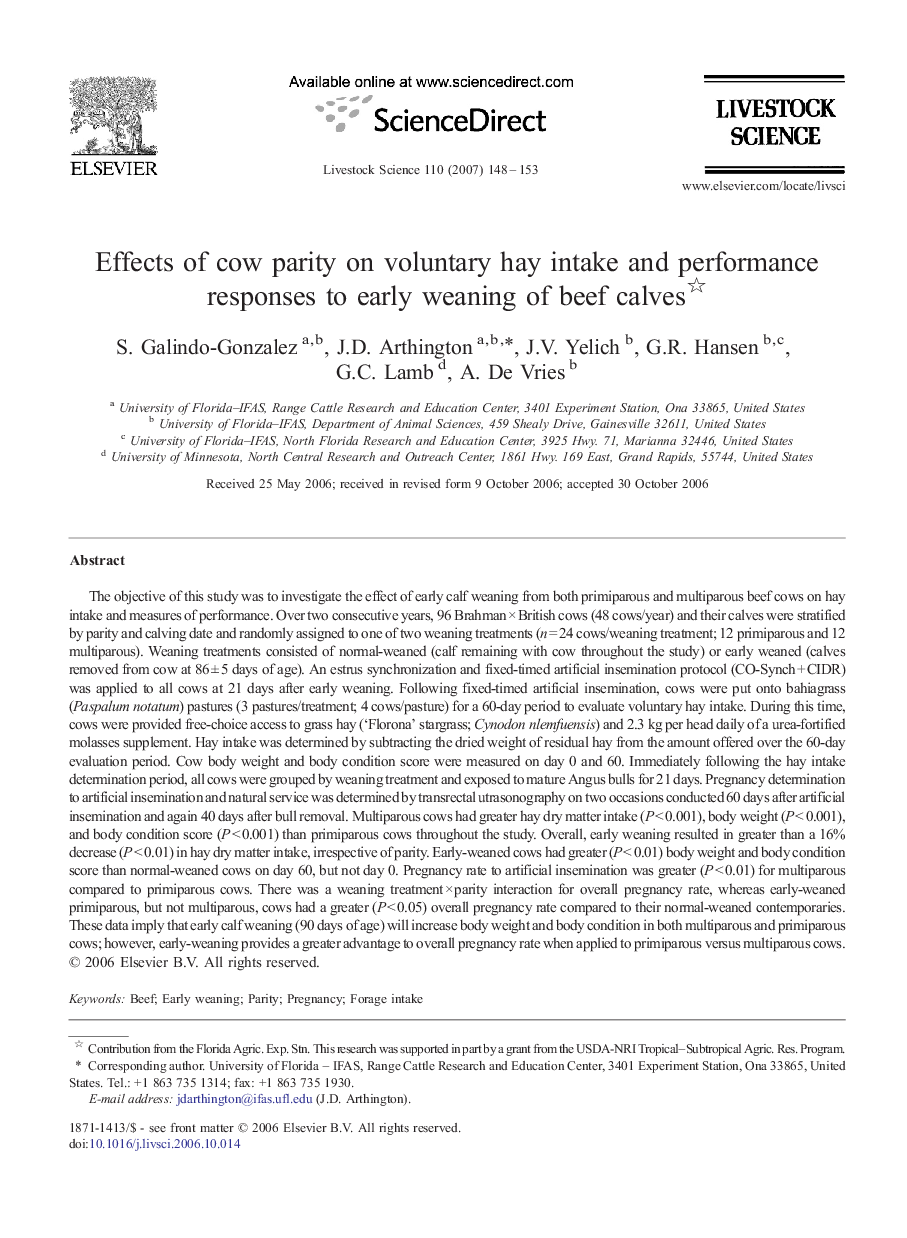| کد مقاله | کد نشریه | سال انتشار | مقاله انگلیسی | نسخه تمام متن |
|---|---|---|---|---|
| 2448960 | 1554024 | 2007 | 6 صفحه PDF | دانلود رایگان |

The objective of this study was to investigate the effect of early calf weaning from both primiparous and multiparous beef cows on hay intake and measures of performance. Over two consecutive years, 96 Brahman × British cows (48 cows/year) and their calves were stratified by parity and calving date and randomly assigned to one of two weaning treatments (n = 24 cows/weaning treatment; 12 primiparous and 12 multiparous). Weaning treatments consisted of normal-weaned (calf remaining with cow throughout the study) or early weaned (calves removed from cow at 86 ± 5 days of age). An estrus synchronization and fixed-timed artificial insemination protocol (CO-Synch + CIDR) was applied to all cows at 21 days after early weaning. Following fixed-timed artificial insemination, cows were put onto bahiagrass (Paspalum notatum) pastures (3 pastures/treatment; 4 cows/pasture) for a 60-day period to evaluate voluntary hay intake. During this time, cows were provided free-choice access to grass hay (‘Florona’ stargrass; Cynodon nlemfuensis) and 2.3 kg per head daily of a urea-fortified molasses supplement. Hay intake was determined by subtracting the dried weight of residual hay from the amount offered over the 60-day evaluation period. Cow body weight and body condition score were measured on day 0 and 60. Immediately following the hay intake determination period, all cows were grouped by weaning treatment and exposed to mature Angus bulls for 21 days. Pregnancy determination to artificial insemination and natural service was determined by transrectal utrasonography on two occasions conducted 60 days after artificial insemination and again 40 days after bull removal. Multiparous cows had greater hay dry matter intake (P < 0.001), body weight (P < 0.001), and body condition score (P < 0.001) than primiparous cows throughout the study. Overall, early weaning resulted in greater than a 16% decrease (P < 0.01) in hay dry matter intake, irrespective of parity. Early-weaned cows had greater (P < 0.01) body weight and body condition score than normal-weaned cows on day 60, but not day 0. Pregnancy rate to artificial insemination was greater (P < 0.01) for multiparous compared to primiparous cows. There was a weaning treatment × parity interaction for overall pregnancy rate, whereas early-weaned primiparous, but not multiparous, cows had a greater (P < 0.05) overall pregnancy rate compared to their normal-weaned contemporaries. These data imply that early calf weaning (90 days of age) will increase body weight and body condition in both multiparous and primiparous cows; however, early-weaning provides a greater advantage to overall pregnancy rate when applied to primiparous versus multiparous cows.
Journal: Livestock Science - Volume 110, Issues 1–2, June 2007, Pages 148–153